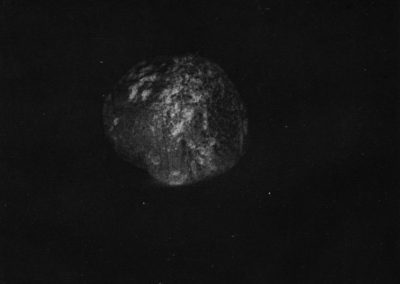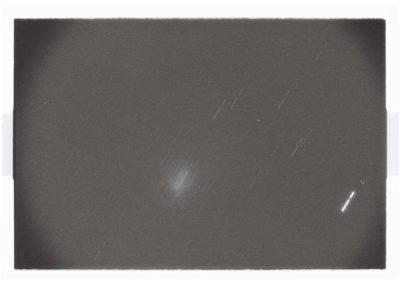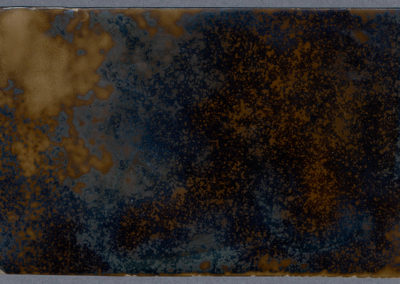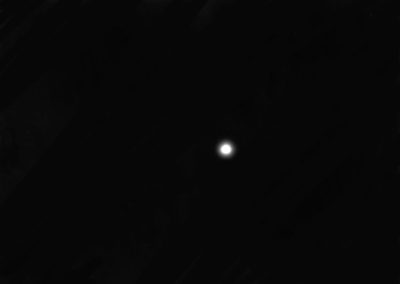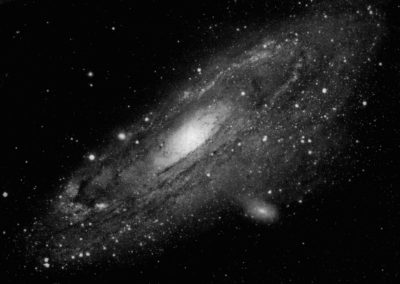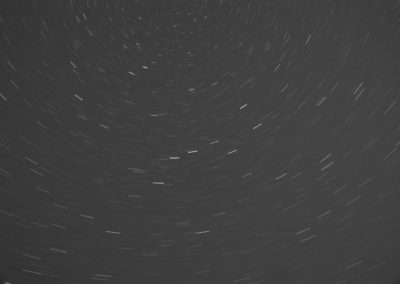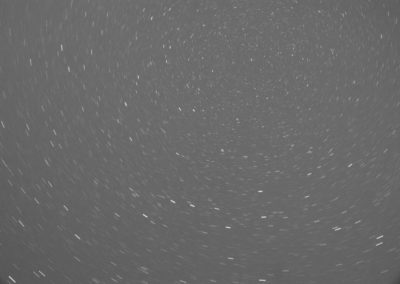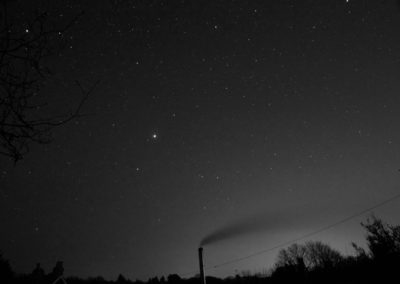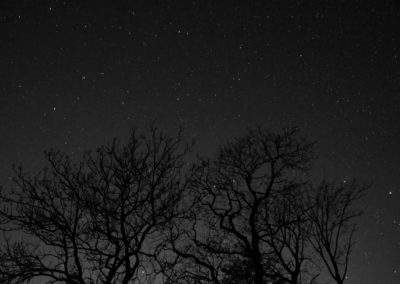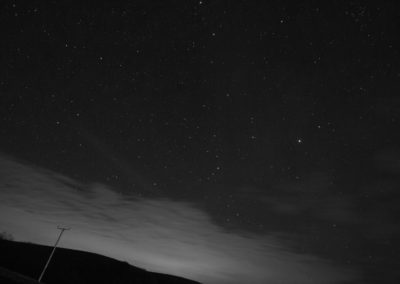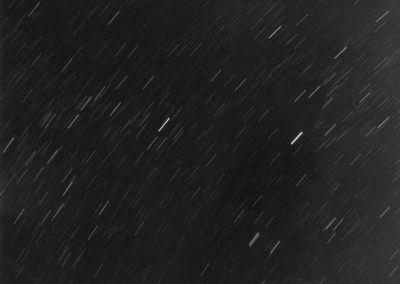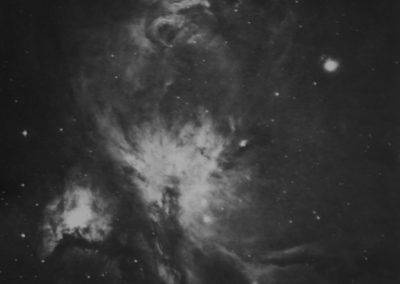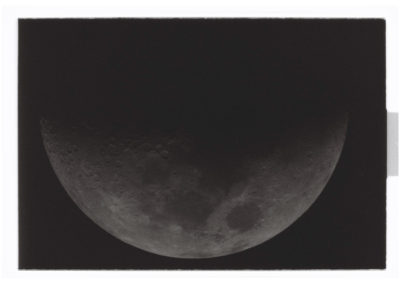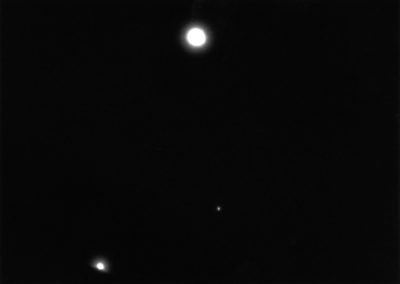First Light:
1. the time when light first appears in the morning; dawn.
2. the first use of a telescope to take an astronomical image after it has been constructed.
3. In physical cosmology, first light refers to the light emitted from the first generation of hyperstars, formed less than a billion years after the big bang.
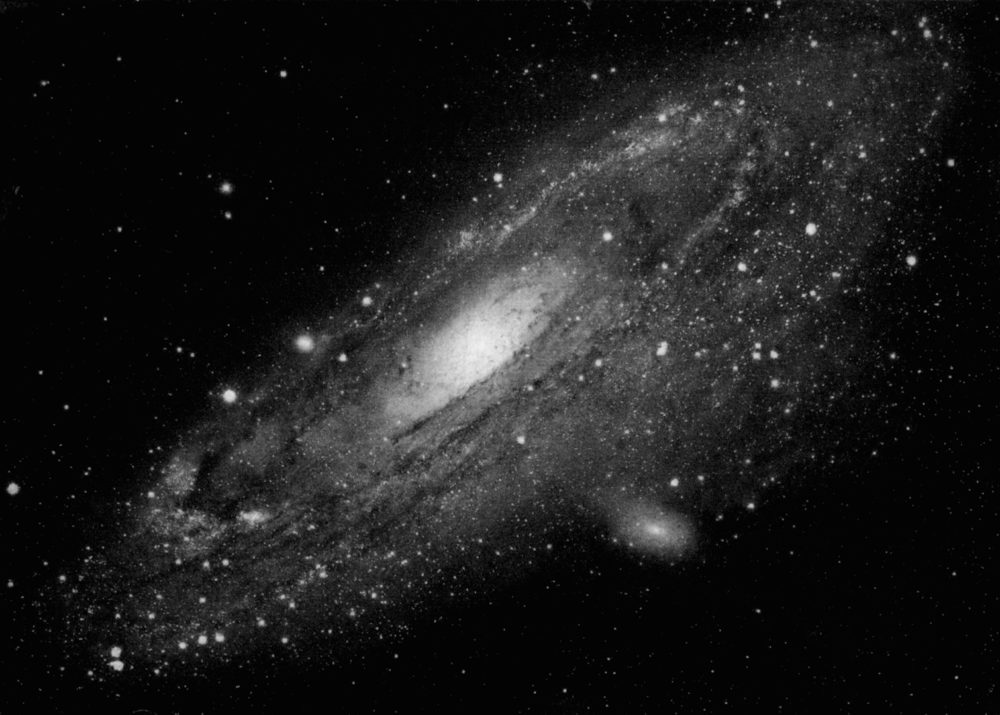
Andromeda Galaxy – 2015
First Light is a ongoing, practice-based research project, exploring the relationship between astronomy, light, photography and materiality.
First Light is inspired by the historical narratives relating to the pioneers of photography in relation to the history of astronomy. For example, it is well known that William Henry Fox Talbot invented the salt printing process, but he was also an official observer of the solar eclipse in 1851. Similarly, John Herschel, the inventor of the cyanotype process and of photographic fixer, and was also responsible for naming several moons of Saturn. James Clerk Maxwell presented the first durable colour photograph in 1861, yet he also made a contribution to our understanding of electromagnetism and discovered that the rings of Saturn are made of small particles. It is also noted that Louis Daguerre, inventor of the daguerreotype, was in contact with Francois Arago, director of the Observatoire de Paris. These connections led me to understand that the study of astronomy, light, photography and materiality are deeply connected. For this reason, I was inspired to try out analogue astrophotography for myself..
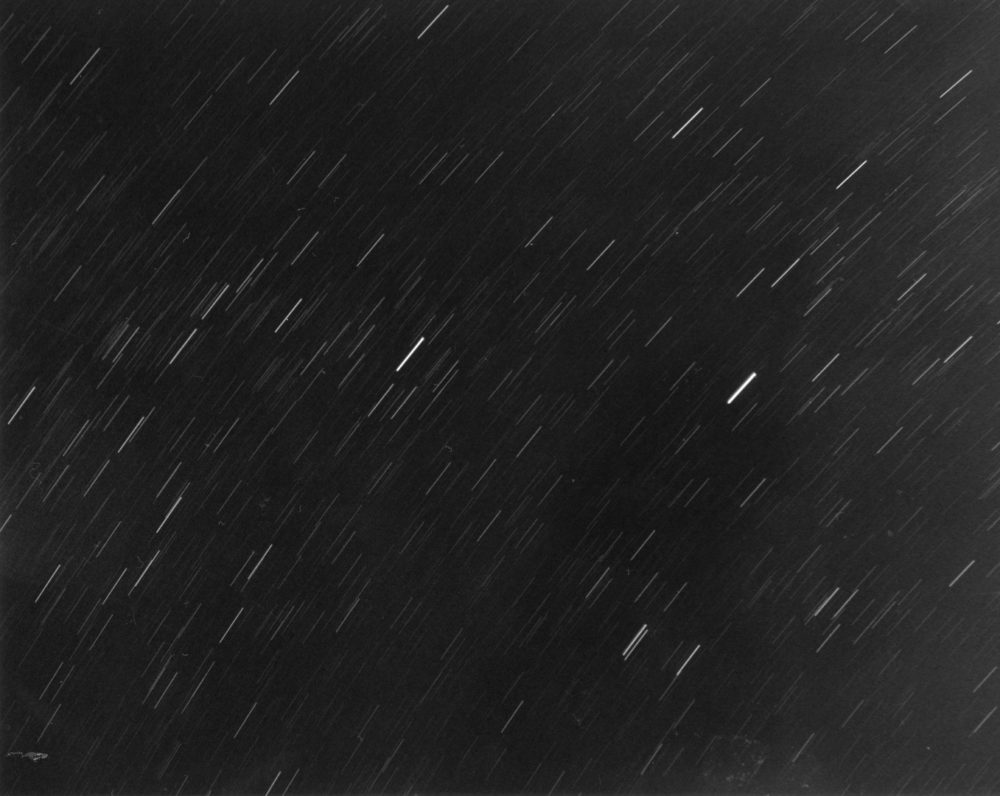
Star Trails Campo Catino – September 2016 – Ilford Delta 3200 – Celestograph
I began by creating a number of photopolymer photogravures of NASA images during a residency at Four Corners Film in 2015. The photopolymer photogravure is a printmaking process, which results in a high quality intaglio photographic prints. The carbon black intaglio ink used in the photogravure print appears black as it reflects little light in the visible part of the electromagnetic spectrum. Coupled with the texture of the Hahnemuhle paper, the images produced feature large areas of velvety black, which seems appropriate for the representation of the void of space. Due to the continuous tone of the photogravure print, wispy details present in The Orion Nebula can be maintained. The photogravure was developed by William Henry Fox Talbot and Nicephore Niepce, and was used as a popular method of reproducing photographic images due to the level of continuous tone and sharp detail. It should be noted that carbon black was traditionally made from the charring of organic materials, mimicking the perpetual process of the destruction and reconstruction of carbon atoms caught within the stellar furnace of a dying star.
Additional to the photogravure prints, I obtained licensing rights from the Museum of the History of Science in Oxford to reprint JW Draper’s Stereocard of the Moon as a silver gelatin photograph. Visitors to the exhibition were invited to view the 3-Dimensional Moon image through an antique stereo-viewer, as Draper intended for it to be seen. Stereoscopic photography was a novelty in the nineteenth century, as it enabled viewers to experience flat photographs as if they were three dimensional using optical effects. To create a stereoscopic image, it is necessary to take two photographs of the same object from two different horizontal positions. This was often done with a stereo camera incorporating two lenses, or by using one camera moved from one position to another between exposures. It is probable the JW Draper took one image of the moon at moonrise, and took another image of the Moon at moonset. This technique was often used to take photographs of celestial objects in the nineteenth century, so that the face of the Moon is centred and the image appears to bulge outwards. As the viewer’s eyes are covered by the stereoviewer eye piece, the observer becomes immersed in the image of the Moon. Looking through the stereoviewer with enough imagination, it could be possible to imagine oneself hovering above the Moon.
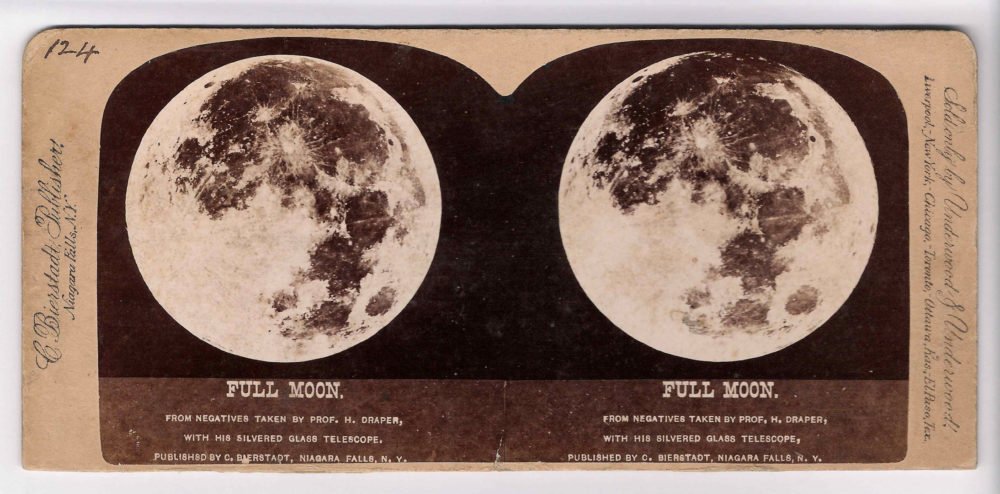
Draper Stereograph of Moon – Museum History of Science
Following this residency at Four Corners, I began studying towards a PhD at the Royal College of Art to consider the relationship between astronomy, light, photography and materiality in more depth. It seemed clear to me that, alongside appropriating NASA images with a variety of nineteenth century printing processes, I should also start to create my own observations of celestial objects.
I began by working with meteorite material as part of my series, Meteotypes, created using ink imbued with meteorite fragments. Within this project, I specifically explore the curious interaction between the function of images and how they are caused. The Meteotype is a photographic etching print where the ink forming the image is imbued with the very same material that it represents. The image is “caused” in the indexical sense where light bounces off of an object and into the camera. However, it could be said that the viewer has a ‘physical’ connection with the original meteorite, which has been transformed into ink.
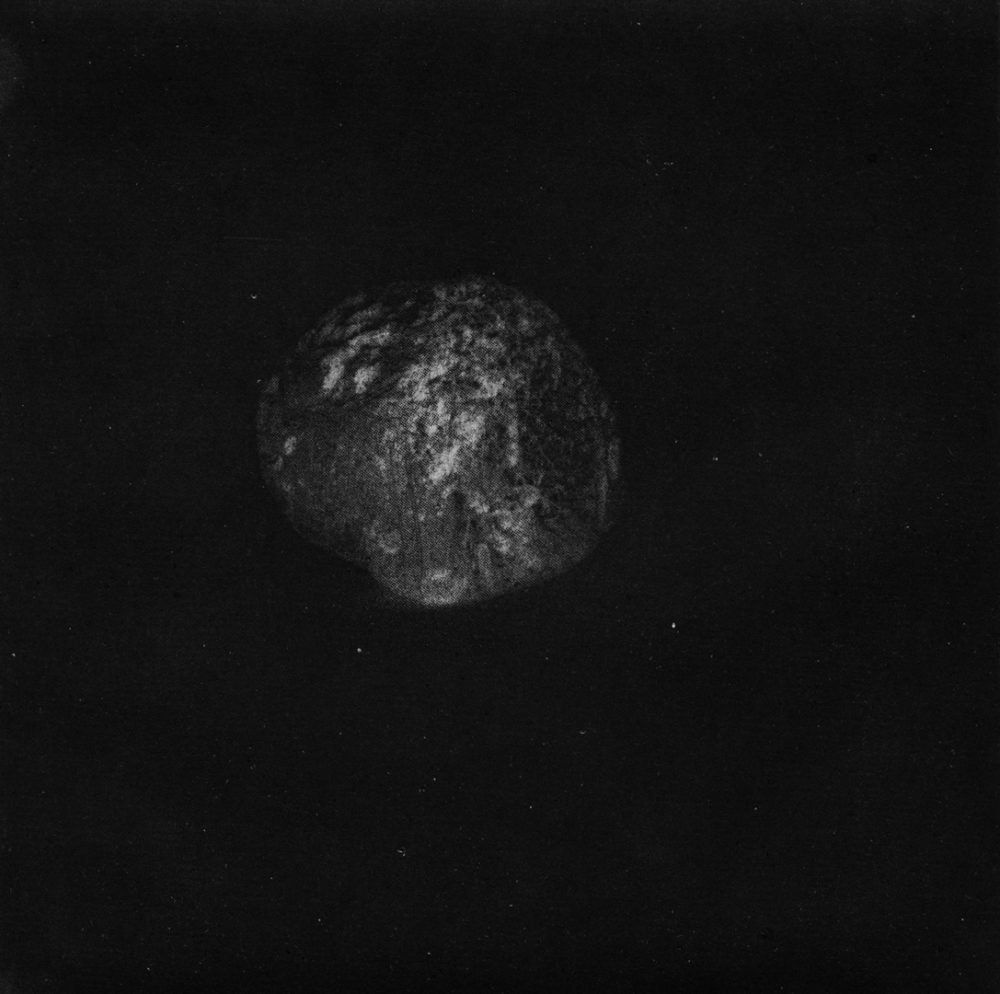
Meteotype – 2016
Later on in 2016, I came across the term celestograph, which was first used in the 1890’s by August Strinderg, a Swedish playwright. Strindberg laid out a series of photographic plates on the ground, hoping to capture scenes of the night sky. Of course, Strindberg did not capture scenes of the night sky, but instead created what we would now describe as a “chemigram”, an image that is created by chemicals interacting with photosensitive emulsions. These photosensitive plates were not designed to be left outside exposed to the elements and thus reacted strangely, resulting in images that evoke scenes of the cosmos. The the term “Celestograph” could be used to investigate a variety of interactions between celestial objects and matter here on Earth. To understand the meaning of “Celestography” let us briefly return to the etymology of the word “photography”.
The word photography is an amalgamation of the Greek word photos meaning light and graphe meaning drawing. In it’s most fundamental sense, photography simply means “to draw with light”. If we then apply the same logic as used for photography, celestography means “to draw from heaven”. The etymological origin of the word “celestial” comes from the latin “cealum” and is the source of the usual word for “sky” in most latin-based languages. In modern times, the term “celestial” is most commonly used to describe astronomical objects, such as stars or planets. A celestial object exists outside of Earth’s stratosphere, beyond the reach of the sky
Over the past year, I have been working to create “celestographs” in a number of ways. A cyanotype could be defined as a “celestograph” when exposed by sunlight, as ultraviolet light from the Sun directly affects photosensitive material. I have been investigating the relationship with the Sun and cyanotypes since 2013, when I began my project “Beyond The Violet” capturing ultraviolet light from the Sun each day (one spin of the Earth on it’s axis) for one year (one Earth orbit around the Sun). This investigation also led to the creation of two world record cyanotype collaborations.
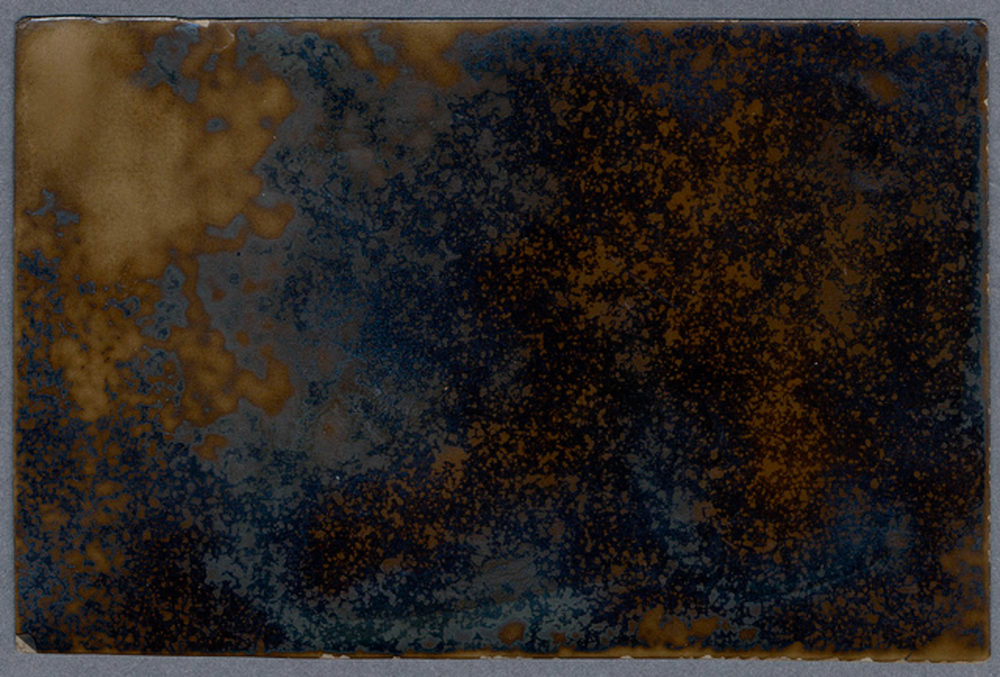
Celestograph 1
In the past year, I have been lucky enough to take analogue photographs of celestial objects through large telescopes at Kielder Observatory and at the UCLO Observatory. Here, I aim to capture light that has been travelling for thousands, if not millions of years, directly onto photosensitive film. I have also been seeking opportunities to visit dark sky areas, to take star field photographs. So far, I have visited the Campo Catino Observatory in Italy, Dartmoor, Kielder and the Lake District to take these photographs.
Darkness has become an increasingly dominant feature in my research. Darkness is necessary for me to take an astronomical photograph and to develop an image in a photographic darkroom, a red light is used for seeing in both scenarios. I am also interested in metaphorical darkness, to explain what we do not know or that which absolves categorisation.
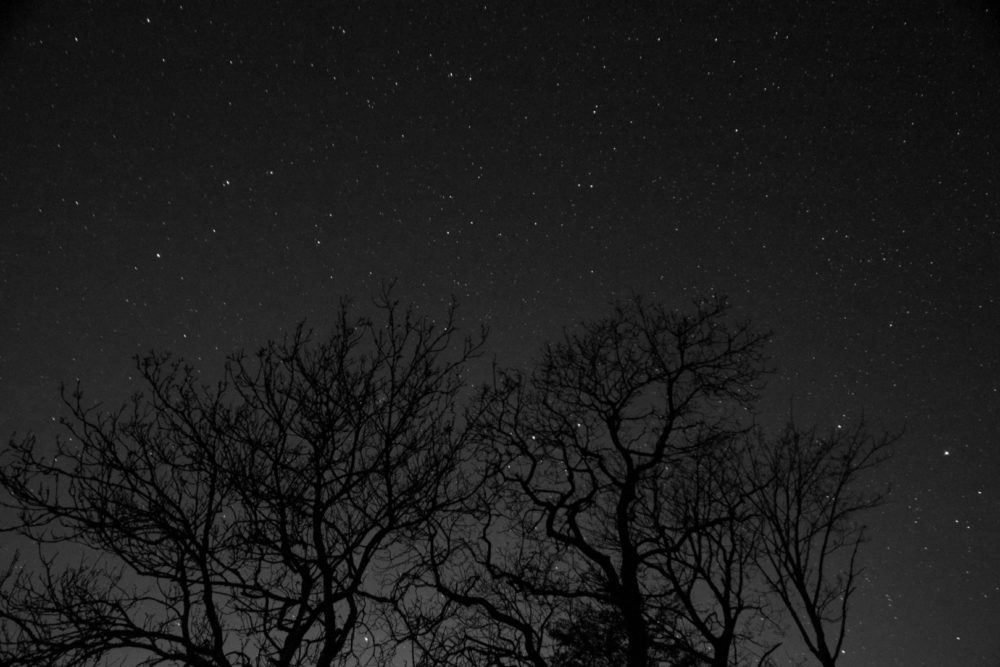
Stars on Dartmoor – April 2017 – Digital
Alone in the darkness of Dartmoor, under the Milky Way, I felt terrified of something that I couldn’t put my finger on. The stars felt as if they were pressing down on me and I found it hard to breathe. Since childhood I have felt a certain level of unease when thinking about the sublime vastness and complexity of the universe. This feeling of fear manifests itself in fascination, and is now the driving force behind my practice. The work I do is a way of trying to understand celestial objects, by coming into contact with them in some way.
First Light series of images by Melanie King
ABOUT MELANIE KING
Melanie is a Multi-Disciplinary artist and curator with a specific focus on astronomy.
She is co-Director of super/collider, Lumen Studios and the London Alternative Photography Collective. She is a member of ITACCUS (The Committee for the Cultural Utilisation of Space) in association with the International Astronautical Federation.
Melanie is currently studying towards a PhD at the Royal College of Art. See RCA Research Profile.
Melanie’s research is concerned with the visual language that is currently associated with astronomy. Melanie seeks to find our how visible and invisible celestial objects and phenomena are represented in the field of art and science. Her research compares how these images are produced, disseminated and interpreted.
The visual language currently used in the field of astronomy, specifically Hubble imagery, relies upon sophisticated composite imaging techniques, which has led to a “false” perception of what we might see through the lens of a telescope. Astronomical institutions often mediate an image before it is viewed by the general public, where colours are added that are informed by processes such as spectroscopy. Following the advent of social media and news images, these highly mediated images have become widely distributed.
Through the production of a series of artworks, Melanie considers how it is possible to ‘come into contact’ with celestial objects using a variety of representational techniques. Alongside scientific institutions, Melanie’s research considers how astronomical images are constructed, and suggests a number of alternatives.
Melanie works with photography, video and sound/data visualisation techniques. The artist often seeks opportunities to directly view and capture celestial objects, and benefits from journeys to dark sky areas. Recent projects include photographic etchings made from meteorite fragments, a series of oscillograph installations fed by pulsar and cosmic ray data, daguerreotypes of the planet Mercury and a series of photographic prints caused by the sun, moon and stars. Also in 2017, Melanie has been working with Kielder Observatory and the UCLO Observatory to capture photographic images of stars and planets directly onto photographic film.
Website: melaniek.co.uk
Twitter: @MelanieKKing
Instagram: @MelanieKAtKing
CREDITS
Unless otherwise stated, all words and images in this article are © Melanie King

